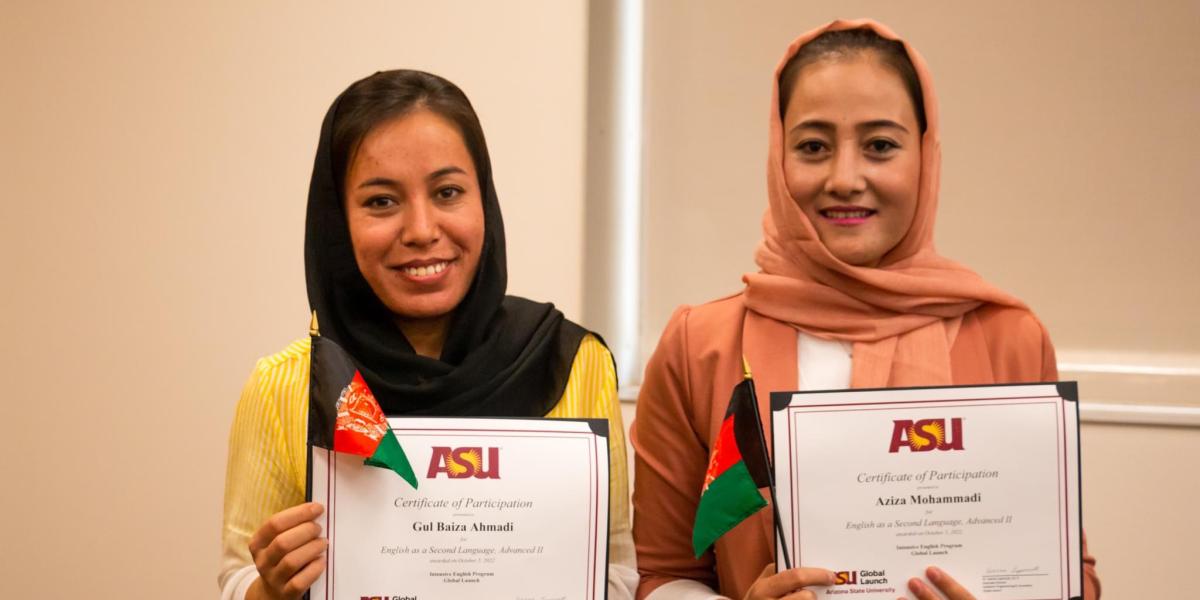Finding a Home on Campus

As wars, natural disasters, persecution, and other devastating circumstances increase around the globe, the topic of refugee and displaced students is at the forefront of international education. There are 108.4 million refugees worldwide, according to the Global Trends: Forced Displacement in 2022 report from the United Nations High Commissioner for Refugees (UNHCR), the United Nations’ refugee agency. That’s an increase of 19 million people compared with the end of 2021.
“It is the largest ever increase between years,” according to UNHCR's statistics on forced displacement.
Campuses across the United States and other countries can expect the number of refugee and displaced students seeking admission to continue to grow. Providing access to education for refugees can be transformative, allowing young people to thrive and build sustainable futures. Thus, the UNHCR aims to increase higher education enrollment among refugees from the current 7 percent to 15 percent by 2030. (Enrollment has already increased from 1 percent in 2019.)
“It’s important for universities located in safe places to provide opportunities for refugee and displaced students to complete their education,” says Pamela DeLargy, executive director of Education for Humanity at Arizona State University (ASU) and professor of practice in ASU’s School of Politics and Global Studies. “If they’re able to go to university and become professionals in the fields of their choice, that’s a great way to integrate them into U.S. society and also a great benefit for our country’s economy.”
Refugee students face many of the same challenges as other international students: culture shock, language barriers, and isolation from loved ones. However, many of these students have also faced unimaginable trauma, including violence and separation from their families. And many are also concerned about family members remaining at home in the face of dire economic circumstances or dangerous living conditions.
“It’s important for universities located in safe places to provide opportunities for refugee and displaced students to complete their education."—Pamela DeLargy
Programs at two U.S. universities—ASU and Eastern Connecticut State University (ECSU)—illustrate how institutions are finding ways to help these populations access education.
Arizona State University: Delivering Education Where It’s Needed Most
Recently recognized with a Senator Paul Simon Spotlight Award for Campus Internationalization, ASU’s Afghan Women’s Education Project is just one of many initiatives within the university’s Education for Humanity program. That larger initiative was launched six years ago to deliver online university courses to refugees and marginalized populations wherever they are. The program currently serves more than 2,000 students across the globe, partnering with organizations such as UNHCR.
In the wake of a refugee crisis prompted by the U.S. military’s withdrawal from Afghanistan in 2021, many colleges and universities across the globe offered support to Afghan students and scholars. ASU accepted 67 Afghan students from the Bangladesh-based Asian University for Women (AUW). The students had been sent home at the onset of the COVID-19 pandemic to continue their studies online.
“ASU was already strongly committed to higher education for refugees, globally and locally,” DeLargy says. When the Taliban resumed control of the Afghan government in August 2021, the AUW women were among thousands desperate to flee Kabul. Miraculously, they were evacuated and eventually enrolled at ASU. Now, the university is committed to helping each student complete her degree, tapping into philanthropic support to cover tuition, room and board, textbooks, and other required fees. Local businesses, charitable organizations, and generous individuals are providing personal items such as clothing and toiletries.
Establishing the Afghan Women’s Education Project required coordination across campus, involving almost every part of the university. The admissions office, for example, handled transcripts and credentialing, while student support services managed academic and housing needs. And staff members in student health services prepared to meet unique medical concerns and mental health needs.
ASU’s International Students and Scholars Center also works closely with DeLargy’s team, providing support for integration into social life on campus, advice on immigration issues and transcript evaluations, and more.
“Refugee students don't fall exactly under an international student office,” DeLargy says. “They have a different immigration status and slightly different needs, but there is also significant overlap of their needs with other international students. So, it's really important for all of us to be working closely together. Our international office does so much to try to help international students feel at home at ASU, so their skills and experience is an invaluable resource for also helping refugee students feel at home.”
Even ASU dining services have been involved. For example, during the month that the university’s Muslim students celebrated Ramadan—a religious holiday that involves daily fasting until sundown—the dining halls on campus extended operational hours to allow the students to eat at appropriate times.
"Our international office does so much to try to help international students feel at home at ASU, so their skills and experience is an invaluable resource for also helping refugee students feel at home.”—Pamela DeLargy
“It’s been a pretty intensive process of strengthening all of the parts of ASU to respond and support our refugee students,” says DeLargy, noting that community organizations, such as resettlement agencies and nongovernmental organizations, are also critical partners. “One of the lessons we learned is that when you strengthen things like trauma-informed instruction, or you strengthen training for residence hall advisers about the special needs [of] refugees, you make life better for all students. You make other students aware of the importance of thinking about what everybody has gone through.”
Eastern Connecticut State University: Creating a Welcoming Space
At ECSU, participating in federal programs such as the Welcome Corps on Campus has enabled the institution to play a role in resettling refugee students in the United States. Launched by the U.S. Department of State in July, the Welcome Corps on Campus is part of a broader private sponsorship program to support refugees admitted through the U.S. Refugee Admissions Program. Participating U.S. higher education institutions enroll refugee students in degree programs while private sponsors provide additional support.
Refugee students at ECSU are served by University Opportunity Programs, a department that supports a wide range of unique student populations, including undocumented immigrants (DACA), first-generation students, and those brought up in the foster care system. The office also oversees international student services.
By forging partnerships with local businesses and individuals, ECSU’s Opportunity Programs can provide a wide range of services, from academic, social, and mental health support to tutoring, scholarships, and basic needs such as grocery gift cards, hygiene products, and laundry detergent.
“We really try to tackle any barrier they might face to be successful in college,” says Christina Irizarry, assistant director of Opportunity Programs. “It’s also important for us to create an environment of connection where we make ECSU feel as close to home as possible.”
Irizarry and other team members in Opportunity Programs do that by listening to student needs. One forum for that is the Student Advisory Board, which includes a representative from each group served by the office. Additionally, the department’s peer mentorship program allows students to build connections on campus and share their stories.
"Sometimes it’s about giving students a space where they can just be themselves and share their stories – just allowing them to miss home."—Christina Irizarry
“They can voice what their different groups need and what kind of programs or activities they are interested in,” Irizarry says. “And sometimes it’s about giving students a space where they can just be themselves and share their stories – just allowing them to miss home. Sometimes students need that confirmation that it’s okay to miss home.”
Helping Refugee Students Thrive
Despite the extraordinary challenges refugee and displaced students have faced, their determination to pursue higher education and build a strong future indicates their resilience. By building partnerships across campus, institutions can help the students thrive. The positive contributions they make to U.S. society are worth the effort.
“A university education allows people the opportunity to work towards that American dream,” says ECSU President Elsa Núñez. “The students are inspiring because they’re hardworking and they’re ambitious, and they're grateful because they've seen what's happened in their countries, where they lost everything. We want them at our institution because they're intelligent, they're motivated, and they're committed to the values of a democracy.”
“The students are inspiring because they’re hardworking and they’re ambitious, and they're grateful because they've seen what's happened in their countries, where they lost everything."—Elsa Núñez
The same is true of the Afghan women at ASU. The first of the group graduated in May with a master’s degree in finance, and 10 more are on track to graduate in May 2024. Most of the students work part- or full time to help support their families back home, while still thriving academically.
“They enjoy having fun too!” DeLargy says. “You can find them in the gyms, on their bikes and skateboards, out dancing and enjoying all sorts of local events. They also give back, as many volunteer in the community. The university community has benefited so much from having them.” •
NAFSA Resources
- “Humanizing Internationalization in the Context of Permanent Displacement,” Trends & Insights
- Information Resources for Assisting Afghan Students and Scholars
- Immigration and Study Abroad Resources: Israel-Hamas Conflict
- Social Justice and International Education, “Integrating Refugees into U.S. Higher Education” chapter and “The Fight for Refugee Children’s Education” essay
About International Educator
International Educator is NAFSA’s flagship publication and has been published continually since 1990. As a record of the association and the field of international education, IE includes articles on a variety of topics, trends, and issues facing NAFSA members and their work.
From in-depth features to interviews with thought leaders and columns tailored to NAFSA’s knowledge communities, IE provides must-read context and analysis to those working around the globe to advance international education and exchange.
About NAFSA
NAFSA: Association of International Educators is the world's largest nonprofit association dedicated to international education and exchange. NAFSA serves the needs of more than 10,000 members and international educators worldwide at more than 3,500 institutions, in over 150 countries.
NAFSA membership provides you with unmatched access to best-in-class programs, critical updates, and resources to professionalize your practice. Members gain unrivaled opportunities to partner with experienced international education leaders.














